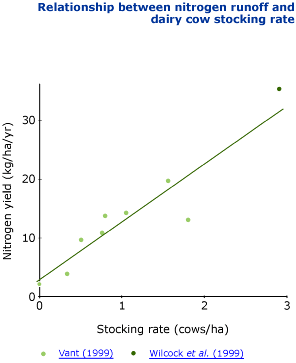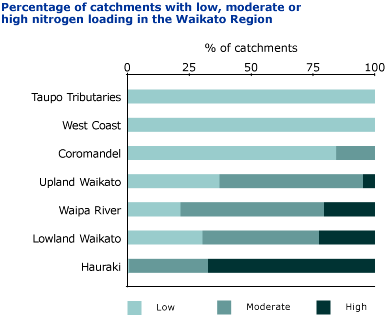Why we monitor nitrogen losses from land
Waikato Regional Council estimates nitrogen leaching and runoff in a representative sample of catchments across the region. This helps us to identify sensitive water bodies at risk of increased nitrogen levels.
This indicator is based on the amounts (loads) of nitrogen getting into our water, either through surface runoff or subsurface runoff (leaching). We calculated it for a wide range of catchments as the area-weighted averages of estimated nitrogen inputs to water.
What's happening?
Our research shows that nitrogen loading into rivers from developed land (non-point sources) in this region is closely related to the average stocking rate of dairy cows. This is because nitrogen in animal urine moves very easily through the soil and groundwater. This makes it possible to use an area’s dairy cow stocking rate to estimate the nitrogen loading into waterways. The information on nitrogen loading in this indicator has been estimated from each area’s dairy cow stocking rate.
- Nitrogen loading is generally low in the less developed upland areas of the region, such as the area around Lake Taupō.
- In the more developed lowland parts of the region, nitrogen loading is often moderate to high. Intensive agriculture - both dairy farming and cropping - is the main source of increased nitrogen loading to the region’s water.
Methods - how we monitor
Results - data and trends
Download the data file
The Excel spreadsheet below contains the source data to this indicator's graphs and any additional data. This data is based on information from the 1997 Farm Dairy Effluent Database.
More information
Further indicator developments
Waikato Regional Council is considering developing an indicator based on a nitrogen leaching index. The new indicator could incorporate the current indicator plus additional information.
When this indicator is updated
There are no plans to update this indicator at present.




 The graph shows strong association between nitrogen load and cow stocking rates. The relationship was highly significant (correlation coefficient = 0.93, p <0.1 percent).
The graph shows strong association between nitrogen load and cow stocking rates. The relationship was highly significant (correlation coefficient = 0.93, p <0.1 percent).


To ask for help or report a problem, contact us
Tell us how we can improve the information on this page. (optional)